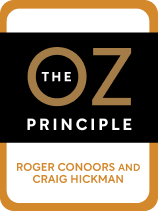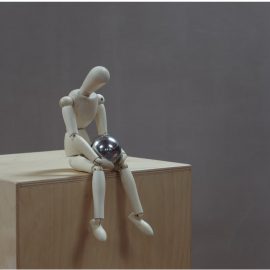

This article is an excerpt from the Shortform book guide to "The Oz Principle" by Roger Connors, Tom Smith, and Craig Hickman. Shortform has the world's best summaries and analyses of books you should be reading.
Like this article? Sign up for a free trial here .
How do you understand personal accountability? What does it really take to assume ownership of your life and hold yourself accountable for its outcomes?
Personal accountability means understanding that you control your own fate. To hold yourself accountable, you have to become comfortable examining the part you play (through action or inaction) in getting into or remaining in negative situations.
There are two steps to this: 1) face the facts, or evaluate problems without flinching from difficult realities, and 2) Admit your role by being honest about how your actions affected the problem. We’ll discuss both of these principles below.
Step 1: Face the Facts
You can’t have accountability if you don’t face the facts of a situation—that is, if you don’t confront reality. The authors contend that facing facts or reality entails dealing with three elements:
1. Changes in Your Surroundings
People often try to carry on as usual when circumstances have changed. It’s irrational, but it’s something we’re all prone to doing. Don’t get stuck in that rut; face the problem and think about how you’re going to adapt. For example, the arrival of a new competitor in your industry might mean your company has to come up with creative ways to stay relevant. Or a loud new neighbor moving in might mean you have to invest in earplugs if you want to sleep through the night.
2. Other People’s Perceptions of You
Sometimes you’ll disagree with another person’s read of a situation, but their opinion has a real impact on you, so you have to make space for it. In your professional life, that person might be your boss or a client; in your personal life, they might be a partner, a child, a relative, or a friend.
For example, if your partner’s version of reality is that you’re not communicative enough, it’s not sufficient to say, “That’s not true,” even if you really believe they’re wrong. You have to confront those feelings and find a way to work it out if you want the relationship to continue—whether that means discussing your communication styles, compromising, or making an effort to change.
(Shortform note: Rather than denying the reality, you can change your behavior plus others’ perceptions of you with three steps: 1) Get more feedback (ask about the impact of your behavior and how you can do things differently); 2) Explain your intentions or the reasons behind your behavior; and 3) Ask others how you’re doing on improving.)
3. Your Own Shortcomings
Be honest with yourself about mistakes you’ve made in the past and areas where you could improve. No one likes feeling as if they’ve done something wrong. It’s easier to push the blame onto someone else, and we have an arsenal of excuses and rationalizations that enable us to do that, telling ourselves: They’re biased, they don’t understand us, they’re not treating us fairly. It feels like a form of self-protection, but it’s actually self-destructive.
For example, if your manager gives you a harsh performance review, your knee-jerk reaction might be denial: They’re biased, you might tell yourself, or they’re treating you unfairly. There may be some truth to those rationalizations, but you’ll benefit more from asking yourself: What if my manager is right? What specifically did they notice me doing—or not doing—that could have contributed to the review they gave me? That line of thinking might help you improve your work and your next review.
Step 2: Admit Your Role
Once you’ve faced the facts of your situation, The Oz Principle’s next step toward personal accountability is to “own” your situation by acknowledging that you’re not only a victim of circumstance, but that you contributed to those circumstances. While this is uncomfortable, the authors point out that it comes with a benefit: Once you realize you had a hand in creating the problem, it’s easier to see how you can create the solution; it’s a way of taking back power.
How to Make Sure You’re Seeing Things Clearly
There are several techniques to help you see patterns of thinking and behavior that are holding you back from acknowledging your role:
1. Self-Assess
Ask yourself, based on prior experiences:
- Whether you’re open to other people’s perspectives
- If you often blame your problems on other people or outside forces
- If you often find yourself thinking that you can’t do anything about your problems
- Whether you’re usually able to admit when you’ve messed up
- Whether you’re comfortable acknowledging that sometimes you’re wrong
(Shortform note: On their website, The Oz Principle authors also offer this expanded 10-question self-assessment. Or, you can try this true-false victim mentality quiz from a counseling service.) This kind of reflection will help you gauge how often you have thoughts that make you a victim, and how much work you’ll have to do to create a mindset of accountability.
2. Be Proactive
If you have doubts or concerns about a situation, pay attention to those feelings; investigate them more deeply. In your professional life, you might make time to double-check your work for errors, research the market so that you’re aware of changes in your industry, and ask colleagues for feedback. (Shortform note: There are three steps to be proactive: Consider what’s likely to happen and plan for it (like setting aside money for vacation), keep up with less-urgent tasks (like preventive maintenance), and prioritize your to-do list and focus on what’s most important.)
3. Take an External Point of View
Imagine giving a friend advice about the same situation. When you think about it as an outsider, can you see what mistakes you made and what you could do better in the future? (Shortform note: Psychologists refer to this as self-distancing: Besides adopting an outside observer perspective, techniques include using third-person pronouns to describe the situation in writing and asking yourself how you’ll feel about the situation a week, month, or years from now.)
4. Learn From the Past
People are prone to falling into patterns of behavior. When you find yourself in a difficult situation, reflect on whether you’ve faced something similar before. Chances are, you have—and, as noted above, you can learn from it.
(Shortform note: Besides reviewing a specific experience, you can make learning from experience part of your routine. In First Things First, author Stephen Covey recommends asking yourself a series of questions each week about how things went, such as: What goals did I achieve and fail to achieve, what challenges did I face and how did I overcome them, what prevented me from reaching my goals, and what are the main lessons I can take away from this week?)
5. Solicit Feedback
Even if you’re good at self-critique, it’s hard to improve without feedback. But people often won’t volunteer it because unsolicited advice is seen as impolite, and it can lead to arguments and hurt feelings. So ask for the kind of feedback you need, and make the other person feel safe sharing their real feelings.
- Let them know you’re looking for the truth, even if it might be hard for you to hear. That way, they know you won’t be upset if they give you anything other than glowing praise.
- Explain why you need the feedback. For example, if you’re trying to improve your work, then your critiquer understands that they’re helping you by giving you insight into what you’re doing wrong.
- Be specific. Rather than asking, “What am I doing wrong?” you might say, “I’m trying to improve my communication style. Have you ever felt like I’m hard to talk to or I’m not listening to you?”
(Shortfiorm note: To get the most constructive feedback possible, you may need to ask questions that are uncomfortably direct. In First Things First, Covey recommends asking these three questions of those close to you to get useful feedback at home or at work:
- What am I doing that you’d like me to keep doing?
- What should I stop doing?
- What should I start doing?)
How you respond to feedback is just as important as how you ask for it. Don’t argue, get defensive, or be dismissive. Even if you disagree, remember that the point of feedback is to make you see something that you couldn’t have seen yourself. Think it over even if you’re not sure you’re going to internalize and act on it. Also, thank your critiquer for their help.
In Thanks for the Feedback, Douglas Stone and Sheila Heen argue that your ability to solicit and incorporate feedback is a major factor in your ability to succeed. They suggest several ways to implement feedback:
1. Focus on one thing: Instead of asking generally for feedback, ask, “What’s one thing you see me doing that I can improve?” Or, ask the feedback-giver what one thing you could do that would make a difference to her personally.
2. Look for options that address the feedback giver’s underlying concern. For instance, if your partner says, “I want you to be on time,” her underlying concern may be that your being late suggests you don’t care about her needs. A solution might be to text her if being late is unavoidable and explain why (to show that the reason isn’t that you don’t care).
3. Test with small experiments: So that change isn’t overwhelming, test the feedback advice in a small way—for instance, if your doctor advises you to change your diet, start by changing one thing, such as eating a piece of fruit with lunch.
4. Motivate yourself to change by focusing on the benefits or by measuring your progress.
Set an Example
Besides helping you grow and succeed, positively receiving and incorporating feedback sets an example for your employees or coworkers. In The Leadership Challenge, James Kouzes and Barry Posner identify five principles of leadership, starting with modeling your values. Part of this is being open to feedback. Similarly, in Radical Candor, Kim Scott discusses creating good practices around feedback among your team by first asking for feedback yourself and modeling a positive response.

———End of Preview———
Like what you just read? Read the rest of the world's best book summary and analysis of Roger Connors, Tom Smith, and Craig Hickman's "The Oz Principle" at Shortform .
Here's what you'll find in our full The Oz Principle summary :
- Why you have more power to create change than you may realize
- How to stop thinking like a victim
- The four steps to mastering accountability






